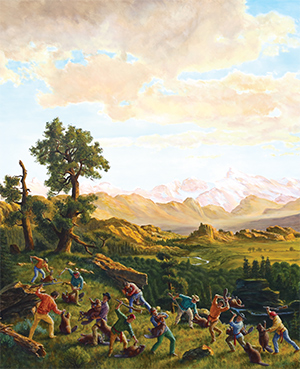
after Rubens, appears in Kent Monkman’s Shame
and Prejudice exhibition, which will tour several
campuses over the next three years.
Painting by Kent Monkman.
Kent Monkman, one of Canada’s foremost interdisciplinary artists, has mounted a new exhibition to coincide with Canada’s sesquicentennial. Shame and Prejudice: A Story of Resilience, a travelling show curated by Mr. Monkman, takes the viewer from the present day back 150 years to focus on atrocities committed by colonizers on Indigenous peoples throughout Canadian history.
Barbara Fischer, executive director of the Art Museum, has worked with Mr. Monkman since 2013 to develop the exhibition, which opened in January. “I was particularly interested in the Indigenous settler relation and how it has developed over the past 150 years and before,” she says. “Our role [at the gallery] is to look at histories … in complex terms and also in critical terms.”
The exhibition touches on key moments in history through paintings, drawings and sculpture by the artist as well as artifacts borrowed from museums and private collections. Mr. Monkman, a queer artist of Cree ancestry, employs his drag persona, Miss Chief Eagle Testickle, as a guide through the show in order to subvert traditional narratives of Indigenous histories in Canada, and to underscore the devastating impact of Confederation on Indigenous communities.
“He kind of considers her a time traveller,” Ms. Fischer says. “The exhibition is constructed in nine chapters that reach back 150 years before Confederation to the era of New France … touch[ing] on the fur trade and ultimately on Confederation and the very specific kinds of events that Confederation unleashed on First Nations, for instance, the building of the railway, the decimation of the bison and the subjugation of First Nations into treaty agreements as a result of starvation.”
The show closes March 5 and will later appear at Queen’s University, Galerie de l’Université du Québec à Montréal and the University of British Columbia, among other venues.